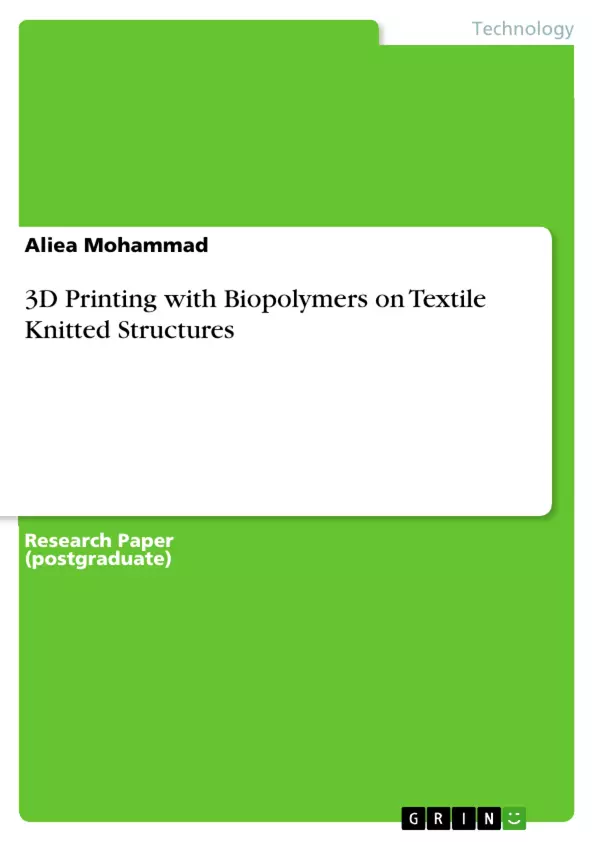Additive manufacturing or 3D printing is the process of turning digital files into physical, three dimensional objects. This is realized using additive processes, which imply successfully laying down very thin layers of material until the object is finalized.
Since invented, it has been used for the purpose of rapid prototyping, and has evolved into a next generation manufacturing technology with the potential of allowing rapid, on site and on demand production of parts and end-products, signaling the beginning of a third industrial revolution.
The aim of this research is to successfully print different three dimensional structures on a variety of knitted fabrics, in order to observe the properties and the behavior of the biopolymers in these circumstances. To do so, 3 separate objects in form of thin rectangles were 3D printed on 7 different surfaces, which were later subject of a peel test that measured the adherence of the polymer to the knitted structure.
Inhaltsverzeichnis (Table of Contents)
- The principle of 3D printing technology.
- Fabrics
- Microscopic view
- Cotton Single Jersey
- Cotton Fleece
- Cotton Pique
- Double knit cotton side
- Double knit polyamide side
- Polyester jacquard
- Polyester warp
- CAD pattern development.
- Polylactic acid
- Printing process
- Pique
- Single jersey
- Fleece
- Double face cotton
- Double faced polyamide
- Weft polyester
- Jacquard polyester
- Separation force test
- Pique
- Single Jersey
- Fleece
- Double knit cotton side
- Double knit polyamide side
- Weft polyester
- Jacquard polyester
- Jacquard polyester washed
- Analyzing post-printing
Zielsetzung und Themenschwerpunkte (Objectives and Key Themes)
This research aims to successfully print three-dimensional structures on various knitted fabrics, investigating the properties and behavior of biopolymers in these circumstances. The study involves 3D printing thin rectangular objects on 7 different fabric surfaces, followed by a peel test to assess the adhesion of the polymer to the knitted structure.
- Exploring the application of 3D printing technology in textile engineering.
- Investigating the adhesion and performance of biopolymers on different knitted fabrics.
- Analyzing the impact of fabric structure and properties on the printing process.
- Developing a comprehensive understanding of the factors influencing adhesion strength in 3D printed structures on knitted fabrics.
- Evaluating the potential of 3D printing for creating functional and decorative textile products.
Zusammenfassung der Kapitel (Chapter Summaries)
The first chapter introduces the principles of 3D printing technology, highlighting its evolution from rapid prototyping to a next-generation manufacturing method. It outlines the research's goal of successfully printing 3D structures on various knitted fabrics and evaluating the adhesion of biopolymers to these surfaces through a peel test.
Chapter 2 provides a comprehensive overview of the different fabrics used in the study, including their microscopic structures and properties. This chapter explores the characteristics of cotton single jersey, cotton fleece, cotton pique, double knit cotton side, double knit polyamide side, polyester jacquard, and polyester warp.
Chapter 3 focuses on the development of CAD patterns for the 3D printed structures, outlining the design process and considerations for ensuring successful printing on the chosen fabrics. This chapter lays the groundwork for the subsequent printing and analysis phases.
Chapter 4 introduces the biopolymer used in the printing process, polylactic acid (PLA), discussing its properties and suitability for 3D printing applications. The chapter highlights the advantages and limitations of PLA as a biopolymer for textile printing.
Chapter 5 details the 3D printing process, explaining the methodology used to print the rectangular structures on the various fabrics. This chapter provides a step-by-step guide to the printing process, including the specific parameters and settings employed for each fabric type.
Chapter 6 presents the results of the separation force test, analyzing the adhesion strength of the 3D printed structures on each fabric. This chapter provides detailed data and graphs illustrating the adhesion performance of the biopolymer on different knitted surfaces.
Schlüsselwörter (Keywords)
The study focuses on the intersection of 3D printing, biopolymers, and knitted fabrics. Key themes include additive manufacturing, material extrusion, Fused Deposition Modeling (FDM), polylactic acid (PLA), adhesion strength, peel test, and textile engineering. The research explores the potential of 3D printing for creating functional and decorative textile products, contributing to the advancement of textile innovation and sustainable manufacturing practices.
- Arbeit zitieren
- Aliea Mohammad (Autor:in), 2016, 3D Printing with Biopolymers on Textile Knitted Structures, München, GRIN Verlag, https://www.hausarbeiten.de/document/340402


